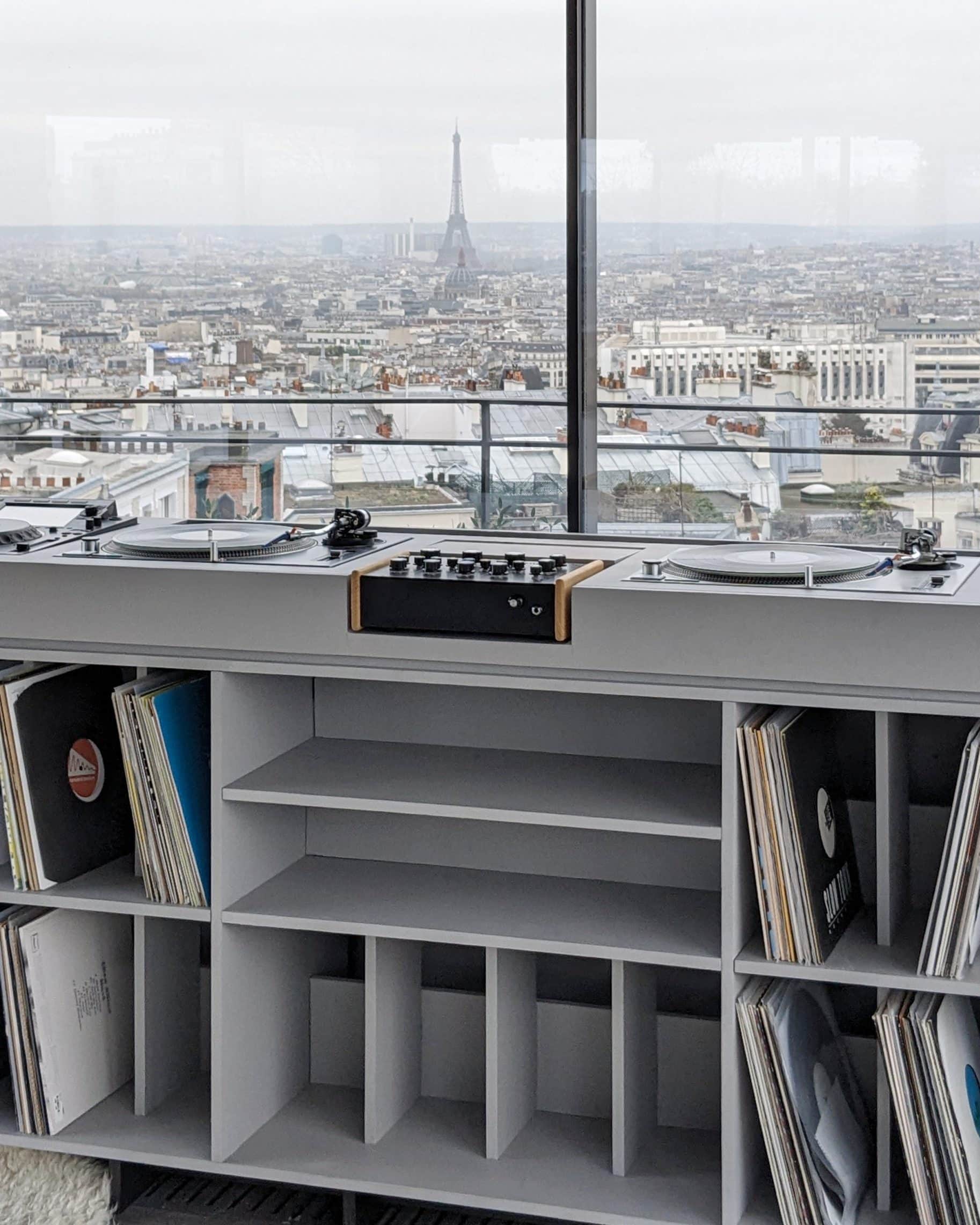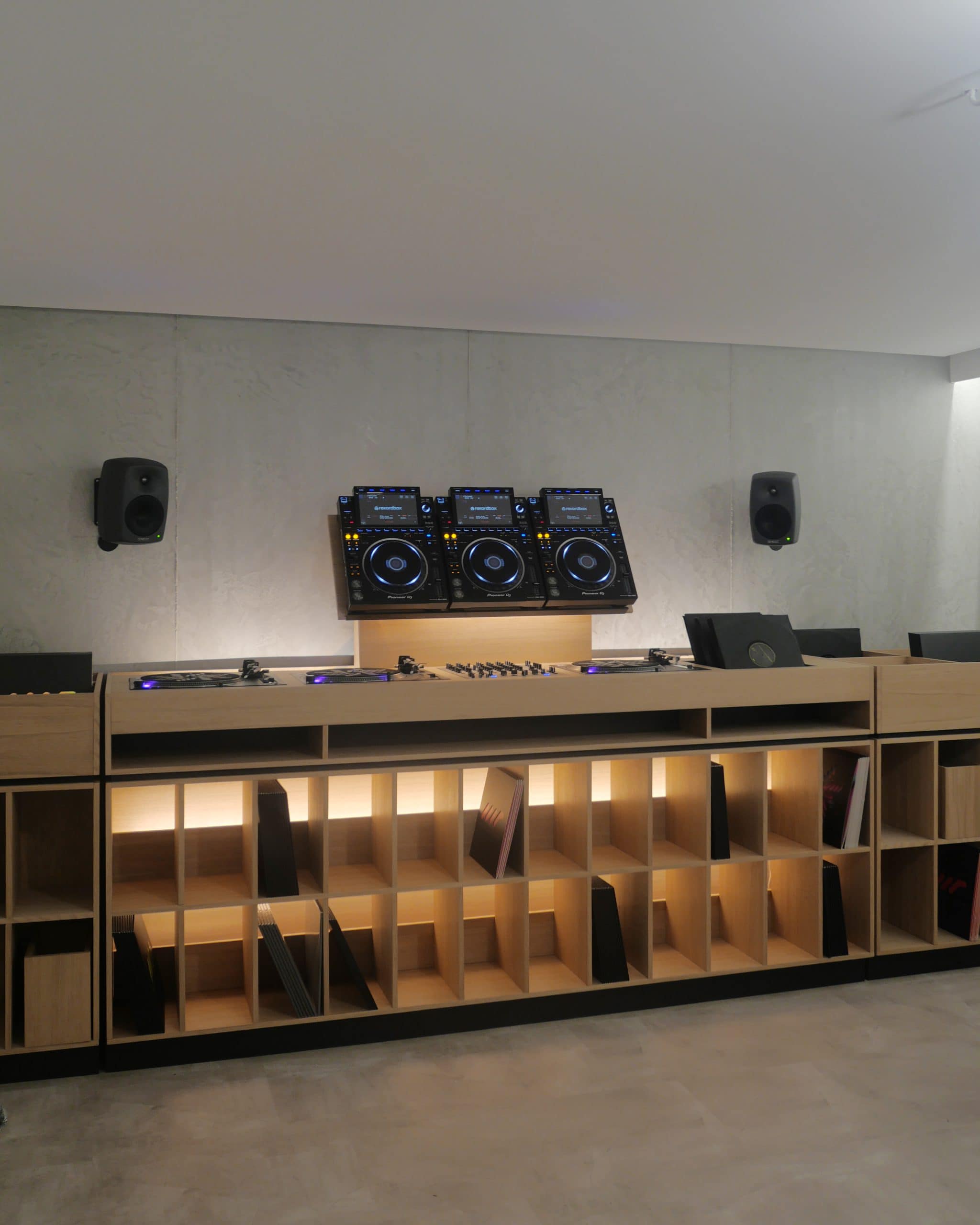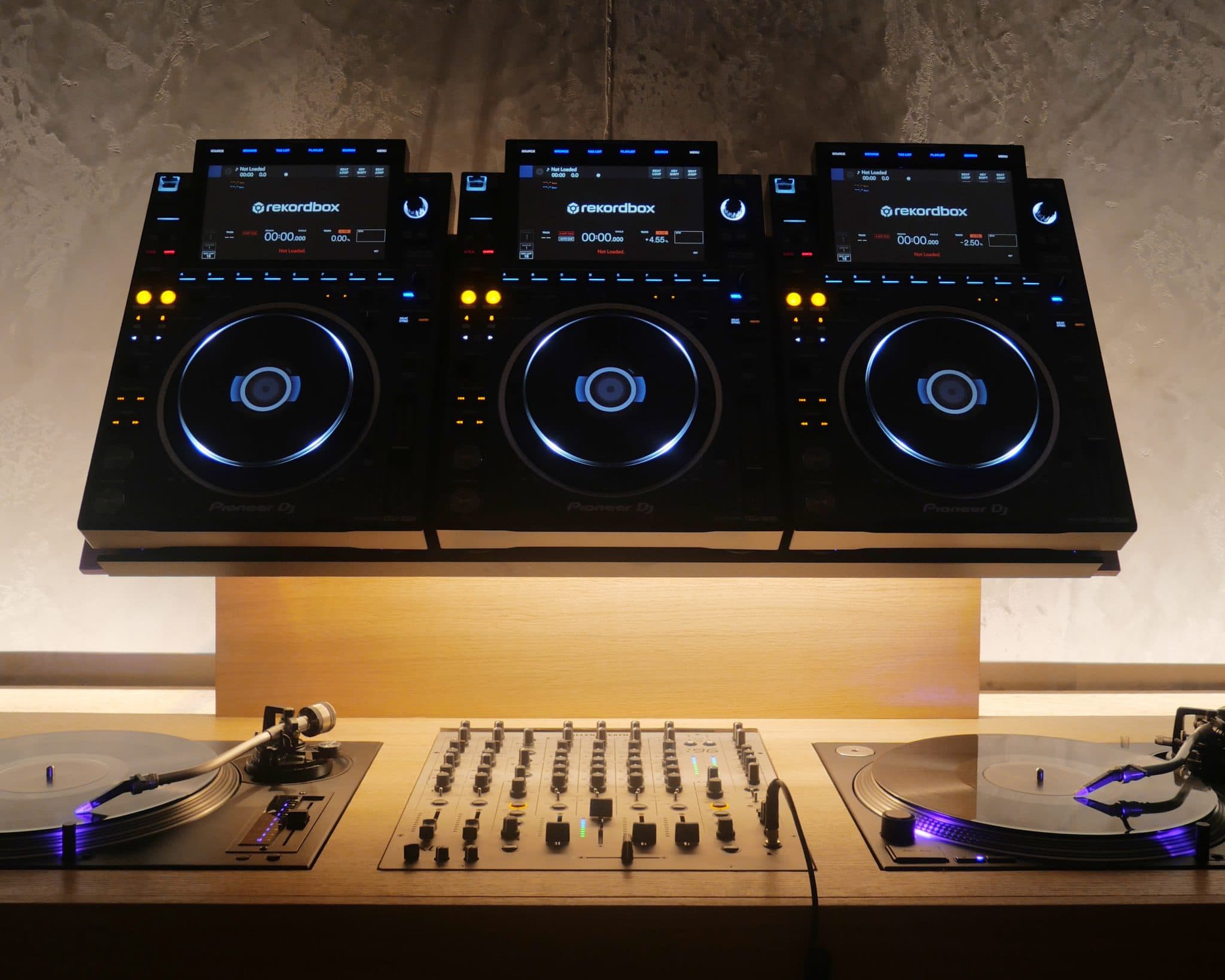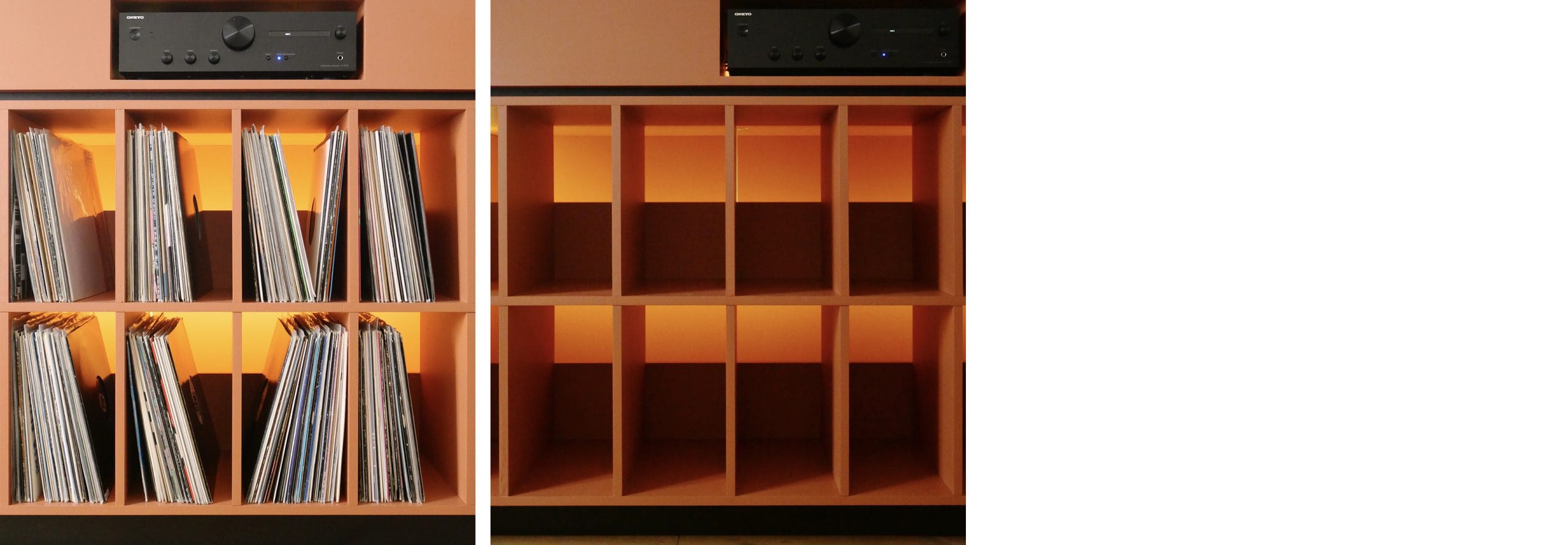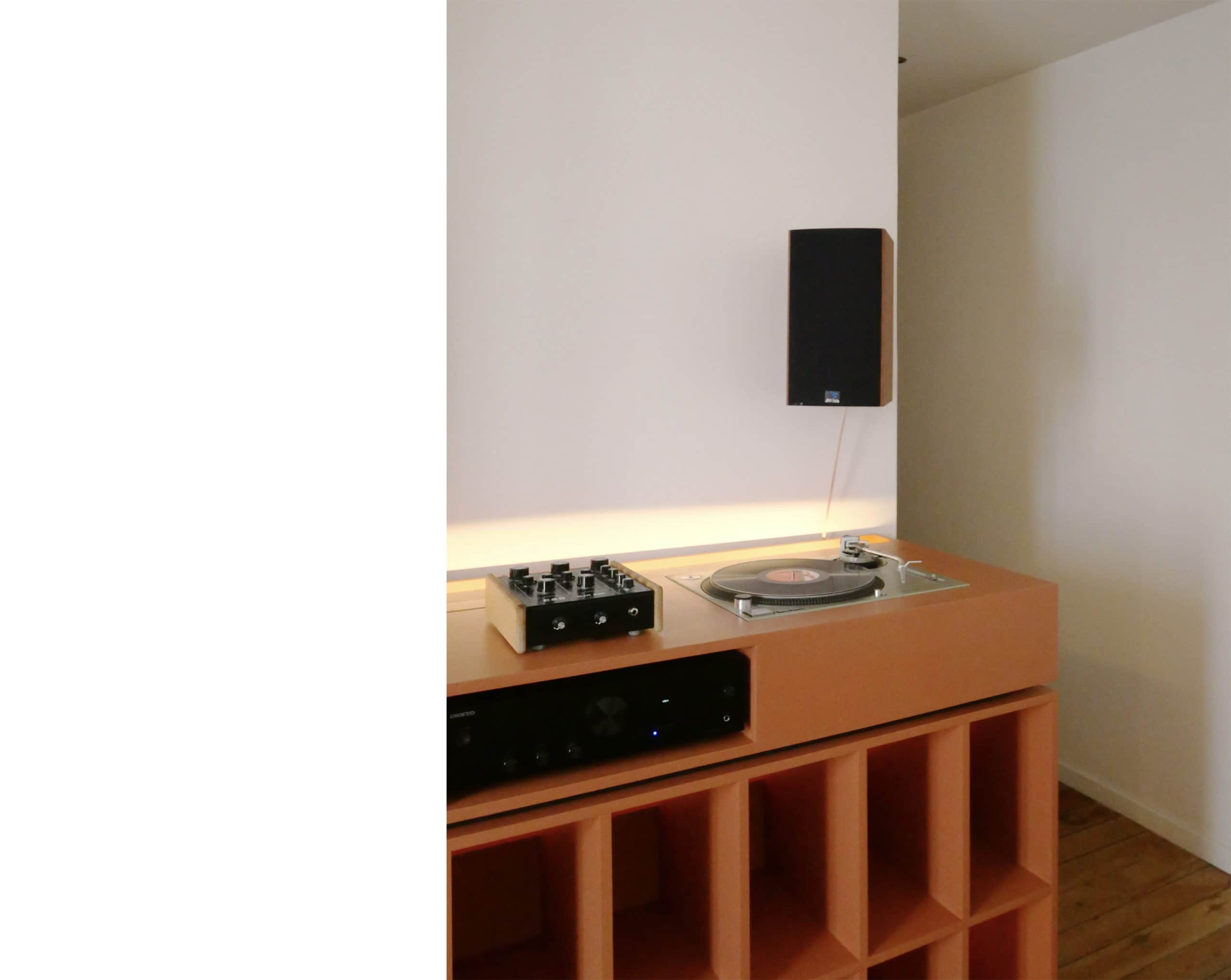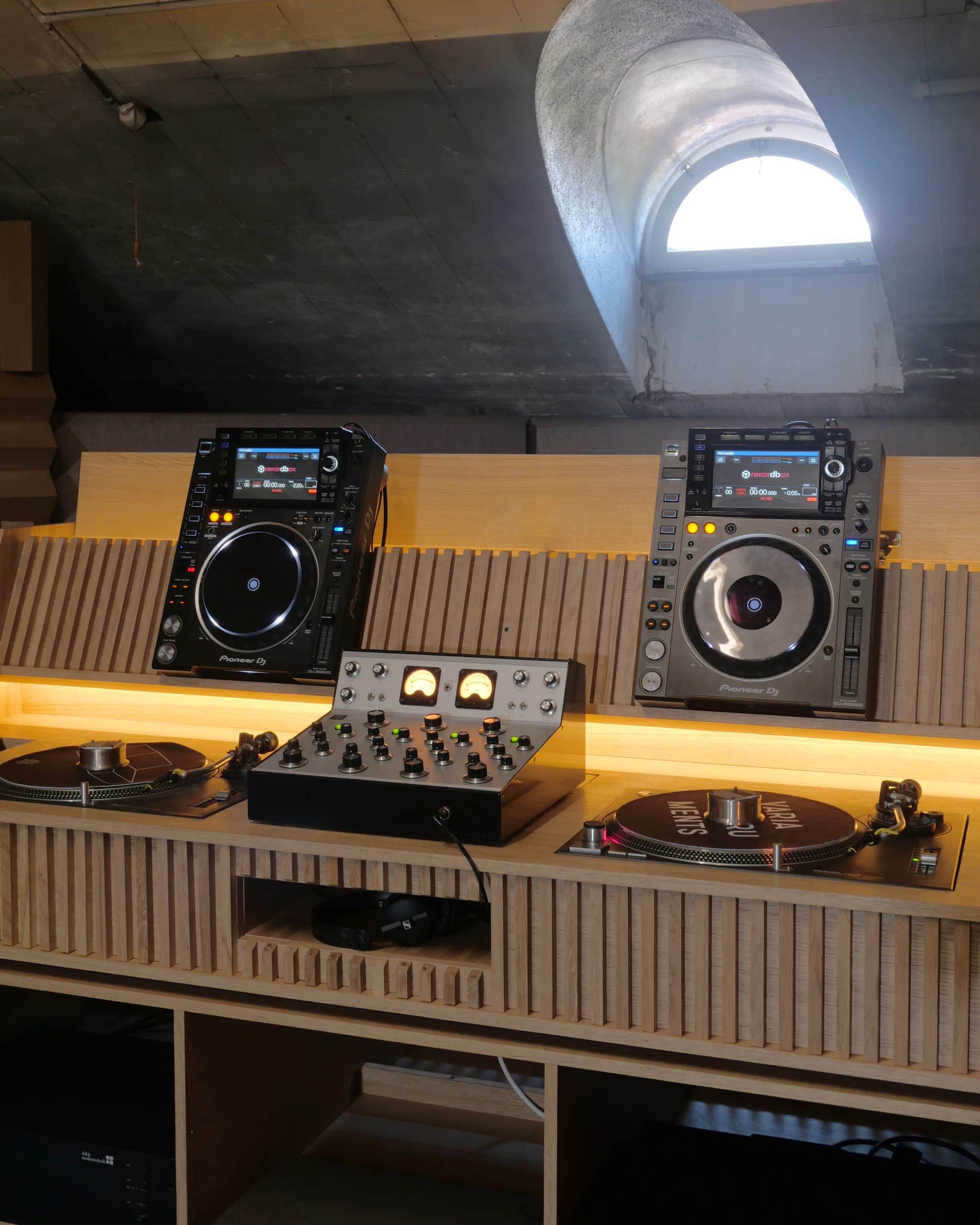JJ Boooth is an independent furniture design service for audio systems and installations. Founded in 2019 by Jeremy Gauvin, the project blends his architectural expertise with cabinet-making and a deep passion for the music scene. Based between Paris and Berlin, the production focuses on creating unique custom-made designs, with the core starting point being the sound system—turntables, consoles, mixing desks, vinyl collections—which is embedded and displayed in the final product. Each unit, a hybrid of furniture, workspace table and mixing desk, emphasises functionality and acoustic quality in a low-tech and minimal style.
Everything stems from Jeremy’s experience and familiarity with audio workstations, enhancing the overall user experience and architectural component. The convergence of music production input and craftsmanship makes each piece a perfect artefact for an optimal aesthetic and functional experience, suitable for a public sound environment or a living space. While music and design occupy distinct realms, they share a common purpose: to create immersive environments and aesthetic pleasure. JJ Boooth embodies this vision: sharing a collaborative creative process to offer a high-quality material and acoustic outcome. We’ll talk with Jeremy about the project and the approach, as well as soundscapes, listening environments, and modern audio systems.
Matilde Crucitti: Hi Jeremy, can you tell me about the beginnings of JJ Boooth?
Jeremy Gauvin: The project started in 2019 in Berlin, after my move from Paris, where I was both an architect and a DJ. Leaving a major architecture firm, I sought to return to music and hands-on work. Once I made my DJ Booth in my first flat, my close friends said “Why don’t you do that for others too?”. Now I work with DJs, collectors, and music producers. JJ Boooth fuses my architectural skills with scenography and DJ furniture design expertise with a focus on woodworking and cabinet making. Each piece is bespoke, crafted to fit unique dimensions, materials and colours tailored to the space.
MC: Can you walk me through the stages of designing a piece and the creative process with clients?
JG: The finest pieces emerge from understanding the customer’s needs (which can involve many emails and calls!): good design is a time-intensive process. It’s a mutual sharing of energies: we choose materials based on their audio setup and/or record collection, then I examine each piece of equipment they use, the size of their record collection, the layout or room for the Booth and the type of records they’ll play. I present various 3D design options, and once a selection is made, I order the materials: I don’t keep stock, minimising waste! Materials range from plywood (sourced from sustainable European forests) to oak, pine, metal, tiles, or paint. I mostly use veneers like oak, walnut, or mahogany for their rich, sophisticated feel. The designs were meant to be disassembled and easily transported. I offer a “premium service”: I assemble the furniture at the client’s location and wire it up, ready for immediate use.
MC: Looking back at your projects, what has been the most fulfilling or the one you aspired to?
JG: My dream is to design a complete room dedicated to records and sound. To date, I’ve worked with top brands like Varia Instruments and New Fidelity, known for their exceptional quality. I’d be thrilled to work with artists to create unique, artistic furniture. The most technically demanding project was for Varia Instruments, known for high-quality handmade rotary mixers. Also, Unit 054 was the largest project I’ve done, delivered abroad right after.
MC: Looking back at your projects, what has been the most fulfilling or the one you dreamt of?
JG: My vision is to design a complete room dedicated to records and sound. To date, I’ve worked with top brands like Varia Instruments and New Fidelity, known for their exceptional quality. I’d be thrilled to work with artists to create unique, artistic furniture. The most technically demanding project was for Varia Instruments, known for high-quality handmade rotary mixers. Also, Unit 054 was the largest project I’ve done, delivered abroad right after.
MC: Does the creative environment between Paris and Berlin influence you? Both cities are renowned for their dynamic music environments.
JG: Paris has my close friends and personal connections, while Berlin is where the action happens in the music scene. I come from the minimal house and techno scene, a tight-knit underground community. France has a clear distinction between house and techno, whereas Berlin is more open-minded with fewer boundaries between different sound styles.
MC: On design, I notice the clean and minimalist aesthetics, with mixers and consoles appearing almost “submerged” within the wooden forms. What constraints do you work with, and who are your theoretical inspirations?
JG: Constraints often spark creativity: having clear guidelines narrows the possible choices, which is beneficial in design! My approach is inspired by the Corbusian points of architecture, reflecting a subtle homage to his methods. For a more avant-garde touch, I look up to architect Louis Kahn, known for his monolithic, almost transcendental geometries. I’m a huge enthusiast of modern architecture and mid-century design, with inspirations ranging from Oscar Niemeyer to Marcel Breuer and Charles & Ray Eames. While there’s a vibrant wave of contemporary designers, I always find myself drawn to the timeless classics.
MC: When design and sound technology intersect, a new aesthetic paradigm emerges, blending tactile and auditory experiences. How do they coexist and harmonise?
JG: To me, aesthetics and sound are part of the same sensory experience when quality is paramount. For instance, a meticulously designed sound system or club can transform the audience’s experience. However, design should complement rather than overshadow the music. My approach is to keep DJ Booth’s understated and low-tech, focusing on functionality over flashy gadgets. The sound system needs to be tunable and feature-rich, like the DSP-integrated speakers we developed with New Fidelity, which adjusts frequencies to match the room and can accommodate additional components. It’s a beautiful thing when technology enhances the experience without being overtly visible.
MC: Indeed, the music industry is taking sound systems, acoustic environments and sound diffusion more seriously, especially with the resurgence of retro music and design trends and a keen focus on listener well-being
JG: It’s all about the quality of experience and acoustic ecology. The interaction between humans and immersive environments should be free from distortions and balanced in frequency articulation. In recent years, there’s been a noticeable increase in attention to sound system quality. However, urban phenomena like real estate development and gentrification pose challenges for clubs, promoters, and festivals trying to create vibrant and safe events.
MC: Talking about sound rooms, resonance and echo, how does a sound environment integrate with a designer’s work?
JG: Music is all about directing sound waves into specific spaces and environments. The designer has a huge impact on how a space “sounds” and the vibrations it emits, just as the acoustician plays a crucial role. Everything aims to enhance the auditory experience. Visually, places like the Ircam anechoic chamber, Robert Johnson in Offenbach, or Public Records NYC come to mind. Last year, I also visited Studio Boyer in Paris, an incredible space where Grammy-winning music is created.
MC: In your opinion, what is the best space for “listening,” and what does “listening” mean to you?
JG: Definitely at home, surrounded by friends and loved ones! I also love a “rave in the woods” with strangers. There’s nothing like a powerful sound system in the middle of a forest at dawn. Listening, to me, is like diving into a sea of frequencies, with waves carrying you to another world.
You probably guessed it, but I’m all about vinyl! When I first walked into my local record shop (Syncrophone, Paris), I was hooked instantly-about 12 years ago: besides the sound and the physical act of handling them, records have the ability to carry memories. Plus, the artwork makes vinyl far sexier than any digital format. I also have memories of my grandfather, an industrial designer, making mixtapes in his little basement studio. He was essentially doing the same thing as a DJ, but with a DIY twist. More recently, I released my first EP as a music producer last year, and I’m really proud of it. It’s amazing to see how far I’ve come-making music almost every day and learning so much!
MC: So, what are you listening to these days?
JG: When deejaying, I’m drawn to those who spin deep, dark, and hypnotic records – those who take risks and stay true to their vibe while keeping their record bags fresh. For me, selection is crucial, especially in the techno realm, my favourite. Names that come to mind are legends like Jane Fitz, Vlada, Vera, Binh, Onur Özer, Masda, and Omar, among others. There are also many talented but lesser-known DJs and collectives, including my close-knit crew, Beau Mot Plage!
MC: Do you feel a pulse of energy and innovation in the music production scene in your city?
JG: The scene is absolutely vibrant right now, almost overwhelming with so much great music. Paris is buzzing with talented producers like Lamalice, Paul Tellimerg, Le Loup, Nils, Gabriel Belabbas, Malouane, Alexis Namur, and Nathan Melja, to name a few. The broader French scene has been super dynamic in recent years. Most of the club music I buy leans towards the sophisticated, with hypnotic vibes and minimalistic touches. Bold basslines, sophisticated drums, and quirky sounds are always welcome; pianos and cheesy vocals are a no-go. I want it to be both playful and serious.
MC: Can you share your thoughts on sound systems, ambient spaces and listening environments?
JG: A perfect experience combines a great vibe, superb acoustics, and an excellent sound system, whether in a club or at home. While I wouldn’t classify myself as an audiophile, the best sound system for me is the one in my own home-where I feel the most relaxed. Regarding clubs, Rex Club in Paris from the 2010s had a phenomenal sound system—I was a regular there-and Hoppetosse around 2020 also impressed me. Those places felt like home to me back then.
MC: What’s next for you in your work? Any dream projects you’re aiming for?
JG: I’m excited about pushing my boundaries: exploring new materials like steel and aluminium and taking my work to an international level, while still emphasising customization and independence. My dream project? Designing a concrete or stone DJ booth for a club-a permanent, almost monumental piece like a sculpture. I imagine it akin to the monolith in “2001: A Space Odyssey”: a DJ booth emerging from the stone, with a sleek, dark presence. My dreams are often filled with these visionary images.
“You can do both. You can focus and be receptive to your surroundings. If you’re tuned out, then you’re not in contact with the process.”—Pauline Oliveros
